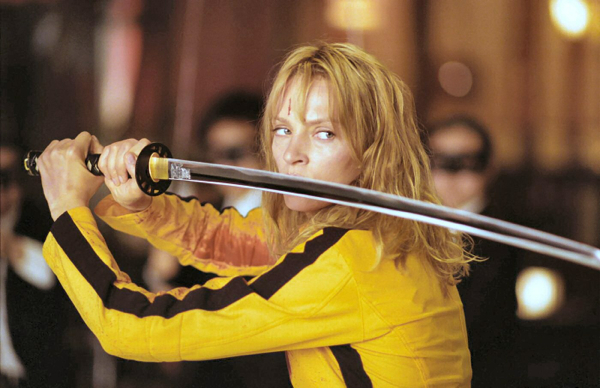Movie review by Greg Carlson
“Kill Bill: Vol. 1,” the first film from Quentin Tarantino since “Jackie Brown” in 1997, is an audacious return to form for the egomaniacal filmmaker. In his movie performances (thankfully absent in “Bill”), his press interviews, and his TV appearances, Tarantino inevitably comes off as a braying, boorish big-mouth. Fortunately for moviegoers, the director is as talented behind the camera as he is insufferable in front of it. “Kill Bill” is another QT mash note to the retro-cool memories of the popular culture that obviously left an indelible impression on the moviemaker in his formative years.
Nothing short of an intertextual minefield that confidently challenges its hardened viewers to identify all of the tributes and references, “Kill Bill” is a candy-colored homage to samurai movies, spaghetti westerns, yakuza flicks, blaxploitation yarns, and kung-fu epics. You don’t even need to wait past the opening credits before the first salvo is fired: a one-two punch that trumpets “Our Feature Presentation” with a vintage 1970s tag and the “Shaw Scope” banner. It’s an announcement that Tarantino is acknowledging his status as the ultimate distiller/recycler/alchemist – if the product wasn’t any good, you’d say he was an outright thief.
The thing is, Tarantino whips up this bouillabaisse like he was born to do it, and the result is trippy, fun, and somehow fresh. The plot is blood simple: Uma Thurman is a deadly assassin nearly done-in by her former colleagues on her wedding day. Miraculously, the Bride survives the attack, which includes a rather nasty bullet to the head, but spends the next four years in a coma. As you might imagine, upon waking up she is more than a little bit pissed off. Cue revenge motif, as the Bride makes it her business to hunt down and kill each of the members of the Deadly Viper Assassination Squad.
What follows is a feverish tour de force of visceral action, in which the director is aided immeasurably by world-class DP Robert Richardson (who has to be one of the best cinematographers on the planet), editor Sally Menke, and production designers David Wasco and Yohei Taneda. The icing on the cake is the excellent music, courtesy of the RZA, with some additional help from Al Hirt, Quincy Jones, Nancy Sinatra, Bernard Herrmann, Ennio Morricone, and a host of others. Tarantino has always demonstrated a flair for reinvigorating old tunes, and it is unlikely that anyone who sees “Kill Bill” will be able to disassociate the creepy whistling of the “Twisted Nerve” theme from the image of Daryl Hannah’s nurse-from-hell Elle Driver strolling down a hospital corridor.
There is so much on display in “Kill Bill,” it is impossible to cover all the bases, but the final “House of Blue Leaves” set-piece, which unfolds in a stunning, bi-level, combination teahouse and disco (that rivals Jack Rabbit Slim’s in “Pulp Fiction”), is utterly unforgettable. The Bride faces Lucy Liu’s O-Ren Ishii and her underworld army, the Crazy 88, in a heart-stopping, Grand Guignol bloodbath that spews fountains of hemoglobin over every available surface. Chiaki Kuriyama, as depraved schoolgirl Go Go Yubari, wields a mace and chain with such elegance and skill, it is no wonder she brings out the best in the Bride and her own weapon of choice: a custom Hattori Hanzo steel. Along with O-Ren, the two make formidable foes, and Thurman meets the challenge with the best performance of her career.
